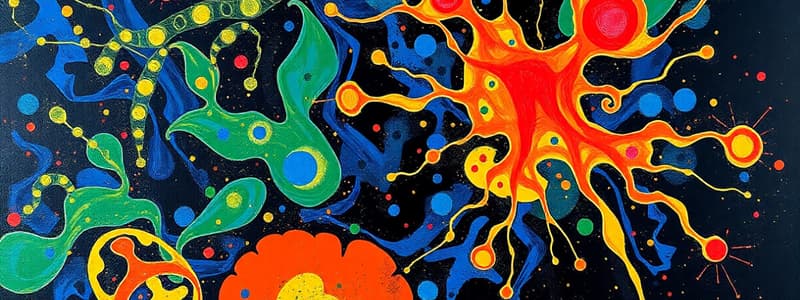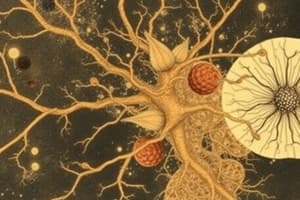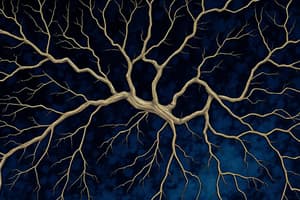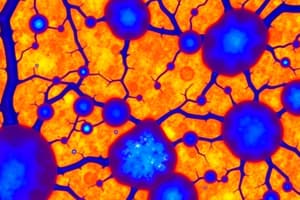Podcast
Questions and Answers
What was the primary innovation of Camillo Golgi's tissue-staining technique that significantly advanced the study of nerve cells?
What was the primary innovation of Camillo Golgi's tissue-staining technique that significantly advanced the study of nerve cells?
- Developing fluorescent dyes that highlighted the synaptic connections between neurons.
- Using osmium tetroxide to provide a three-dimensional view of neurons.
- Creating a method to isolate and culture neurons outside of the nervous system for direct study.
- Employing silver nitrate to stain individual nerve cells black for enhanced microscopic observation. (correct)
How did Santiago Ramón y Cajal's approach to studying the nervous system build upon and differ from Camillo Golgi's initial contributions?
How did Santiago Ramón y Cajal's approach to studying the nervous system build upon and differ from Camillo Golgi's initial contributions?
- Cajal rejected Golgi's staining technique entirely and pioneered a purely observational approach using unstained tissues.
- Cajal simplified Golgi's staining method to make it applicable to a wider range of tissues, unlike Golgi who focused only on brain tissue.
- Cajal focused on the chemical properties of nerve cells, while Golgi was primarily concerned with their structural arrangement revealed by staining.
- Cajal refined Golgi's staining technique and combined it with meticulous observation and detailed drawing to analyze the nervous system's structure. (correct)
What critical shift in the understanding of the nervous system was championed by Cajal's Neuron Doctrine, directly challenging the previously accepted reticular theory?
What critical shift in the understanding of the nervous system was championed by Cajal's Neuron Doctrine, directly challenging the previously accepted reticular theory?
- The Neuron Doctrine posited that nerve cells are functionally independent units, unlike the reticular theory which viewed the nervous system as a continuous network. (correct)
- The Neuron Doctrine focused on the brain's macroscopic organization, while the reticular theory was concerned with the microscopic structure of nerve tissue.
- The Neuron Doctrine claimed that neurons are primarily glial cells, whereas the reticular theory correctly identified neurons as distinct nerve cells.
- The Neuron Doctrine suggested that nerve impulses are transmitted electrically, contradicting the reticular theory's emphasis on chemical neurotransmission.
Despite sharing the Nobel Prize, what fundamental disagreement persisted between Golgi and Cajal regarding the structure of the nervous system?
Despite sharing the Nobel Prize, what fundamental disagreement persisted between Golgi and Cajal regarding the structure of the nervous system?
Cajal's meticulous documentation of his observations included 'over 2,900 drawings'. What was the significance of these drawings in advancing the field of neuroscience?
Cajal's meticulous documentation of his observations included 'over 2,900 drawings'. What was the significance of these drawings in advancing the field of neuroscience?
Which statement accurately reflects the relative impact of Golgi's method and Cajal's work on the progression of neuroscience?
Which statement accurately reflects the relative impact of Golgi's method and Cajal's work on the progression of neuroscience?
What is the most accurate interpretation of Cajal's quote, 'As long as our brain is a mystery, the universe, the reflection of the structure of the brain, will also be a mystery.'?
What is the most accurate interpretation of Cajal's quote, 'As long as our brain is a mystery, the universe, the reflection of the structure of the brain, will also be a mystery.'?
The Cajal Institute in Spain holds over 30,218 items from Cajal's legacy. What is the primary significance of this extensive collection for current and future scientific research?
The Cajal Institute in Spain holds over 30,218 items from Cajal's legacy. What is the primary significance of this extensive collection for current and future scientific research?
Considering the historical context, what was the most significant impediment that both Golgi and Cajal had to overcome in their investigations of the nervous system?
Considering the historical context, what was the most significant impediment that both Golgi and Cajal had to overcome in their investigations of the nervous system?
What was a key characteristic of Cajal's research methodology that contributed to the acceptance of the Neuron Doctrine over the reticular theory?
What was a key characteristic of Cajal's research methodology that contributed to the acceptance of the Neuron Doctrine over the reticular theory?
Flashcards
Golgi's Method
Golgi's Method
A tissue-staining technique using silver nitrate for visualizing nerve cells.
Camillo Golgi
Camillo Golgi
An Italian doctor who developed a technique to observe nerve cells.
Santiago Ramón y Cajal
Santiago Ramón y Cajal
Spanish neuroscientist known for detailed observations and drawings of the nervous system.
Neuron Doctrine
Neuron Doctrine
Signup and view all the flashcards
Reticular Theory
Reticular Theory
Signup and view all the flashcards
Micrography
Micrography
Signup and view all the flashcards
Nobel Prize 1906
Nobel Prize 1906
Signup and view all the flashcards
Cajal Institute
Cajal Institute
Signup and view all the flashcards
Santiago's Reflection
Santiago's Reflection
Signup and view all the flashcards
Cajal's Technique
Cajal's Technique
Signup and view all the flashcards
Study Notes
Cajal and Golgi's Contributions to Neuroscience
- Cajal spent 15 hours a day meticulously observing and documenting nervous system structures, creating over 2,900 drawings.
- His detailed drawings revolutionized the understanding of the nervous system, revealing intricate details of nerve cells in the brain, eye, and spinal cord.
- Cajal's work challenged the prevailing "reticular theory," which proposed a continuous network of nerve fibers.
- He instead advocated for the "neuron doctrine" – the concept that the nervous system is composed of individual, discrete nerve cells (neurons).
- Golgi developed a staining technique (silver nitrate) to highlight nerve tissue structures under a microscope.
- Golgi's technique allowed for better visualization of nerve cells, but he initially struggled to understand their precise connections.
- Cajal refined Golgi's staining methods and observed that neurons were distinct cells connected by synapses.
- Electron microscopy later confirmed Cajal's neuron doctrine, which became the standard model for understanding the nervous system's structure and function.
- Cajal and Golgi jointly received the Nobel Prize in 1906 for their contributions but held differing views on the organization of the nervous system.
- Cajal’s drawings were highly accurate representations of the nervous systems, facilitating a deeper understanding of the nervous system.
Historical Context
- 19th century witnessed a debate between "reticular theory" (nervous system as a continuous network) and the "neuron theory" (discrete nerve cells).
- The neuron doctrine replaced the reticular theory.
- Golgi strongly supported reticular theory, despite evidence to the contrary.
- The development of electron microscopy further supported the neuron doctrine, allowing for visualization of synapses in the early 1950s.
Neuron Doctrine
- The neuron doctrine describes the nervous system as composed of individual, discrete cells called neurons.
- Neurons connect via synapses (gaps), enabling them to communicate and relay signals.
- Specific connectivity patterns determine a nerve cell’s function.
- This model is fundamental to modern neuroscience.
Studying That Suits You
Use AI to generate personalized quizzes and flashcards to suit your learning preferences.





